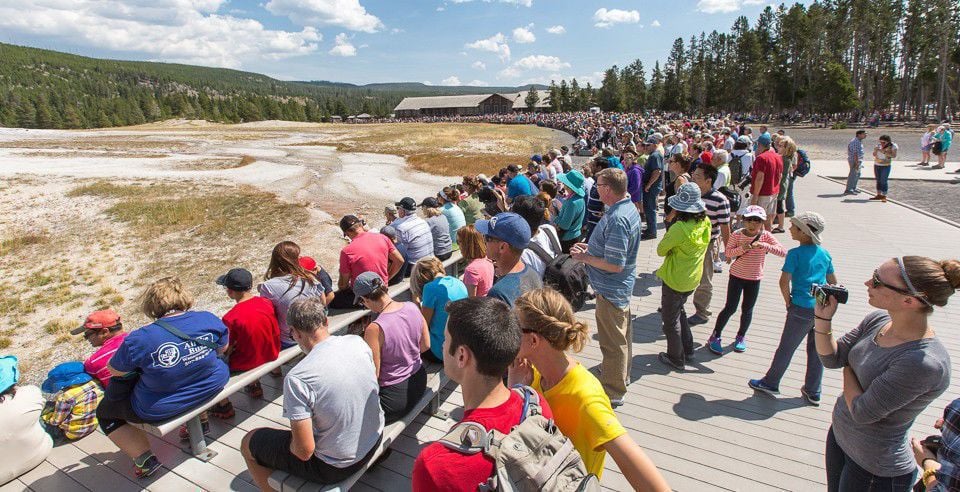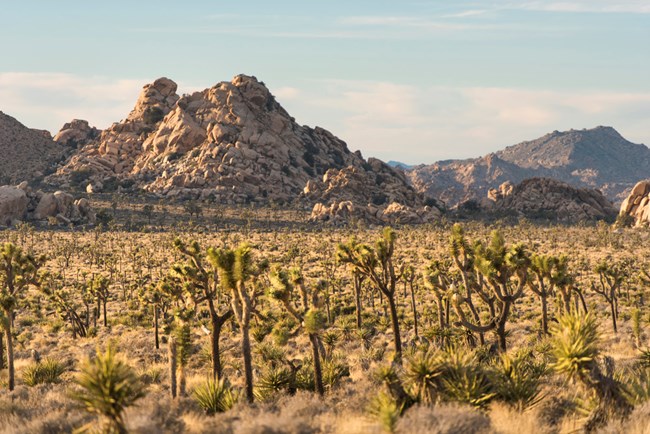 |
| An Entrance of Yellowstone National Park during the 2013 Government Shutdown Source: NPCA Photos, Flickr.com |
The gambit did not work. A different backlash soon spread across the media. Instead of faces of sad children, pictures of trash heaps were shared along with dirty bathrooms and mobs of cars. The masses were allowed into the parks but there was little to no staff to control them. The administration could not avoid the criticism and their decision caused damage to be wrought at numerous National Parks. But public attention and the media cycle are both short, and the government shutdown now seems in the past. Yet the effects of this tumultuous time will be felt in the National Parks and other protected lands for years to come. The litter has been removed and the bathrooms are now clean, but it will take some time before the parks fully recover.
The decision to keep National Parks open during a government shutdown was unusual. Many in the field immediately railed against the choice. Critics argued that public safety and resource protection could not be guaranteed with most of the Park Service staff on furlough. Out of about 20,000 staff, only 3,298 were kept on during the shutdown to cover almost 80 million acres of park land. That is approximately one staff member for every 24,000 acres.
An unnamed Yosemite National Park Ranger posted on social media about the challenges of working with such a small staff, "Today I worked. We held Yosemite open to 4th of July-level traffic with no support staff whatsoever. We did so with four rangers in Wawona/Badger, four in Yosemite Valley, and four in Mather. That is 12 people working while we were seeing 240-270 cars per hour coming into (the) south entrance. Let that sink in. TWELVE people. In a park the size of Rhode Island." The small contingent of staff was soon overwhelmed, and the results were seen across the country in the form of overflowing trash cans, cars parked everywhere they pleased, and bathrooms closed.
 |
| A Crowd at Yellowstone National Park Source: trib.com |
While visitors flowed into the parks, the absence of any support staff meant that entrance and service fees were not being collected. This loss of revenue is no small change. With the numbers that the Park Ranger from Yosemite noted before, it is estimated that the park missed out on $70,000-$80,000 per day. The Park Service as a whole lost $400,000 a day that could have been put towards the $11.6 billion maintenance backlog that the Service finds itself battling constantly. While much of the Parks' budget comes from Congress, the revenue from fees provides a much-needed help to the Service, with some of the larger parks keeping 80% of their entrance fees on site and utilizing them for operating budgets. For the immediate future, the Park Service will have trouble paying for materials, service, and maintenance on its land until it can make up its losses.
Another reason that the shutdown hurt the Park Service, and many supporting services and agencies, is that it happened during the time of year devoted to administration. This may not seem as vital, but administrative projects are some of the most important because they enable all other projects to move forward. That time of year was supposed to be when grants were being written, when seasonal workers were being hired, when project review was underway, and when essential training was being attended. There was no one to do that important prep work for the coming season and those that were working were too busy with the day-to-day operations. This pause in work will keep everyone scrambling during the rest of the season.
To give a specific example on something that is topical, the government shutdown severely interrupted wildfire prevention. During the winter, wildfire crews and conservation agencies are busy with all the administration mentioned previously. But they are also busy performing managed burns. These prescribed burns allow firefighters to preemptively combat the coming wildfire season by burning up excessive fuel. Yet there is only a small window for much of that work to be done and the shutdown slammed much of that window shut. Many fear that this year's wildlife season will be substantially more dangerous as a result.
Yet many issues will not be as visible or devastating as wildfires, some will be slow to progress and thus remain out of the public-outcry machine. For example, now that the shutdown is over, the trash piles have been cleaned up and social media photos of such have lost their poignancy. However, many wildlife officials worry that animals could have been feeding on the trash piles and thus become habituated to associate human food waste as a food source. This habituation is dangerous, as it often leads to hazardous interactions between humans and wildlife, especially with larger animals such as bears. And unfortunately, this habituation is almost impossible to break. If a wild animal becomes severely habituated to human food to the point of numerous interactions, they almost always have to be euthanized due to the public safety risk. Wildlife officials will have to be vigilant in the coming months to see if animals will become reckless because of the access to unmanaged garbage.
| A Trash Pile in the Golden Gate National Recreation Area Source: National Park Service |
During the shutdown, there was also public reports of trespassing, illegal camping, and offroad vehicles in the National Parks. Many of these activities were done in off-limits areas, which were designated as such because they are extremely fragile ecosystems. Even simple disruptions such as hikers off paths and single vehicle tracks could take decades to recover from. A tragic example is Joshua Tree National Park. Extensive damage was done to the park's namesake trees, which can live for hundreds of years and are notably fragile. Unimpeded by the skeleton park staff, visitors broke off pieces of the trees for fires and stomped across fragile soil. Entire trees were cut down to make way for illegal ATV roads. Park management estimates that it will take somewhere between 200-300 years for the area affected to return to its state before the government shutdown. How long would the social media backlash for closed parks have lasted? A few months? Weeks? Well, now there is centuries of damage wrought instead.
 |
| A Landscape at Joshua Tree National Park Source: National Park Service |
The National Park Service is not to blame for the 2019 Federal Government shutdown. Nor can the Department of the Interior, or any other natural resources agency, be expected to solve everything when the Executive Branch and the Legislative Branch come to a stalemate. However, once a government shutdown does occur, it is up to these agencies to correctly manage the resources and the lands that they have been charged to protect. Keeping the gates open and allowing these lands to be utilized unprotected is not following the ethos of conservation, it is merely bowing to public pressure. The people at the heads of these organizations have lost sight of their critical mission. Instead, they have become clouded by the short-term ends of public opinion and political one-upmanship.
I hope that we never have a government shutdown in our country again, at any level: federal, state, or local. But if we do, those in charge of our natural resources must remember that they are sworn stewards. And they must realize that sometimes the only way to protect something is to lock it up and weather the backlash until the storm has passed.
No comments:
Post a Comment